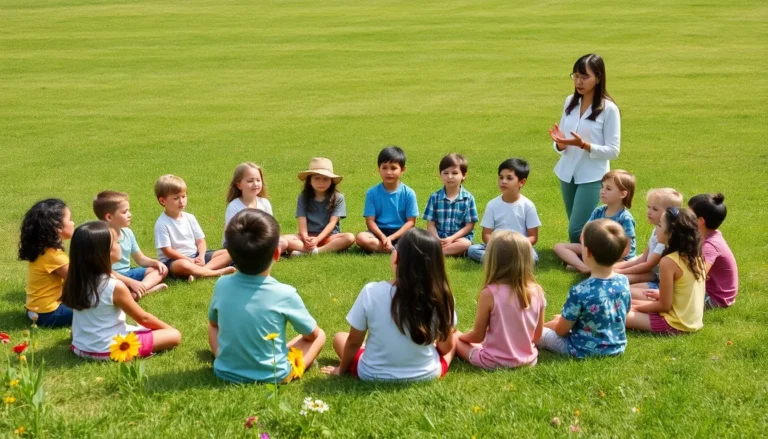Table of Contents
ToggleHigher education is evolving faster than a caffeine-fueled student cramming for finals. With technology advancing and societal needs shifting, colleges and universities are stepping up their game to stay relevant. From online learning to micro-credentials, today’s academic landscape is bursting with fresh ideas that promise to reshape how students learn and grow.
Gone are the days when a degree was just a piece of paper. Now, it’s about skills, flexibility, and a dash of fun. Whether it’s incorporating virtual reality into classrooms or embracing hybrid models that fit busy lifestyles, institutions are finding creative ways to engage learners. Buckle up as we dive into the latest trends in higher education that are not only changing the way students study but also how they prepare for the future.
Overview of Trends in Higher Education
Higher education is undergoing significant transformation due to technological advancements and evolving societal expectations. Institutions are prioritizing skills over traditional degrees to meet labor market demands. Flexible learning options, such as online courses, are gaining traction among students seeking convenience and accessibility.
Innovative learning methods like micro-credentials provide targeted educational experiences, enabling learners to gain specific skills quickly. These trends foster adaptability in an ever-changing job landscape. Virtual reality also plays a key role, with colleges utilizing immersive technologies to enhance student engagement and provide realistic scenarios for practical learning.
Hybrid models are becoming increasingly common, combining in-person and online learning to accommodate diverse student needs. This approach offers a personalized education experience, supporting students with varied learning styles. Additionally, the emphasis on lifelong learning reflects a shift towards continuous skill development, crucial for career advancement in many fields.
Collaboration between academic institutions and industries strengthens the relevance of programs offered. Partnerships enable curriculum development that aligns closely with workforce requirements. Data-driven decisions are shaping these programs, ensuring institutions remain competitive and responsive to student and employer needs.
Embracing diversity and inclusion remains a high priority for many universities, fostering a richer educational environment. Institutions are implementing policies that promote equity in access to education, which supports a more diverse student body.
These comprehensive changes indicate a generational shift in higher education, emphasizing a future-oriented approach that equips students with necessary skills and knowledge for tomorrow’s workforce.
Technological Advancements
Technological advancements significantly shape higher education today. Institutions embrace digital transformation, altering traditional learning approaches.
Online Learning Platforms
Online learning platforms expand education accessibility. Universities leverage these platforms to provide courses that cater to diverse schedules. Students access class materials and interact with peers from anywhere, enhancing learning opportunities. Many platforms now include features like live lectures, discussion forums, and assessments to ensure engagement. This flexibility empowers working professionals and non-traditional students to pursue degrees without geographical constraints.
Virtual and Augmented Reality
Virtual and augmented reality enhance student experiences in higher education. These technologies allow immersive learning environments that simulate real-world scenarios. Students studying medicine, for example, can practice surgical techniques in a safe virtual space. Institutions invest in VR and AR tools to foster hands-on learning, making complex concepts easier to grasp. Both technologies also facilitate collaboration among students and instructors, breaking down traditional barriers in the classroom.
Student-Centered Approaches
Student-centered approaches are reshaping higher education, emphasizing individual student needs and preferences in the learning process.
Personalized Learning Experiences
Personalized learning experiences tailor educational pathways to each student’s strengths and interests. Universities are utilizing adaptive learning technologies to customize content delivery. Faculty members assess students’ progress, adjusting instructional methods accordingly. Engaging with real-time feedback helps students stay on track. Online platforms enable learners to progress at their own pace, fostering autonomy. Many institutions are integrating competency-based education, allowing students to demonstrate mastery before moving forward. This individualized attention enhances retention and satisfaction, significantly improving student outcomes.
Mental Health and Wellbeing Initiatives
Mental health and wellbeing initiatives are increasingly vital in higher education contexts. Institutions recognize the importance of supporting students’ emotional and psychological health. Comprehensive counseling services and wellness programs are now standard offerings. Workshops focused on stress management and resilience are common, helping students navigate academic pressures. Peer support networks foster community, creating safe spaces for dialogue around mental health issues. Furthermore, proactive measures like wellness days and mental health awareness campaigns promote a balanced lifestyle among students. By prioritizing mental wellbeing, universities enhance the overall educational experience, preparing students for both academic success and life beyond graduation.
Changes in Curriculum and Pedagogy
Higher education is adapting to new demands through innovative curriculum design and teaching methods that enhance student learning experiences.
Interdisciplinary Programs
Colleges and universities are increasingly offering interdisciplinary programs that blend diverse fields of study. These programs foster collaboration among students from various disciplines, encouraging them to tackle complex real-world issues. For example, a program combining technology and social sciences allows students to explore the societal implications of digital advancements. Engaging in such programs prepares graduates for a multifaceted job market where cross-disciplinary skills are highly valued. Institutions create opportunities for students to engage with new perspectives, enhancing problem-solving abilities and creativity.
Emphasis on Critical Thinking
Critical thinking skills have become a focal point in higher education curricula. Students are encouraged to analyze information critically and approach problems from different angles. Courses that promote debate, reflection, and interactive discussions help cultivate these skills. Developing critical thinking capabilities equips students to navigate challenges in professional environments effectively. Faculty are increasingly incorporating assessment methods that emphasize analytical capabilities, moving beyond rote memorization. By prioritizing this skill set, colleges and universities prepare students for a rapidly changing workforce, where adaptability and innovative thinking are essential.
Globalization and Diversity
Globalization significantly impacts higher education, promoting diversity and inclusivity across campuses. Institutions worldwide now cater to a diverse student population, fostering a rich educational environment.
International Student Mobility
International student mobility has surged, with over 5 million students studying abroad as of 2020. This trend allows institutions to attract talent globally, enriching the academic experience for all. Academic programs now reflect diverse perspectives, encouraging cross-cultural exchanges. Additionally, universities often partner with international institutions to create exchange programs, expanding learning opportunities. Such initiatives lead to enhanced academic collaboration and networking among students and faculty.
Cultural Competence in Education
Cultural competence has become essential in educational settings, enabling students to effectively interact in diverse environments. Many institutions integrate cultural competence training into their curricula, preparing students for global citizenship. Faculty often incorporate diverse teaching materials to reflect the backgrounds of all students. Workshops and seminars frequently emphasize the importance of understanding different cultural perspectives. As students engage with varied worldviews, they develop empathy and critical thinking skills, essential in today’s interconnected society.
The landscape of higher education is undergoing a remarkable transformation. Institutions are embracing innovative approaches that prioritize skills and adaptability over traditional degree paths. As they integrate technology and flexible learning options, universities are better preparing students for the demands of a rapidly changing job market.
Collaboration between academia and industry continues to play a crucial role in aligning educational programs with workforce needs. By fostering diversity and inclusivity, higher education is not only enriching the academic experience but also cultivating a more equitable environment for all students.
These trends underscore the importance of student-centered learning and mental health initiatives, ensuring that institutions support the holistic development of their students. As higher education evolves, it remains committed to equipping learners with the tools they need for success in an interconnected world.






